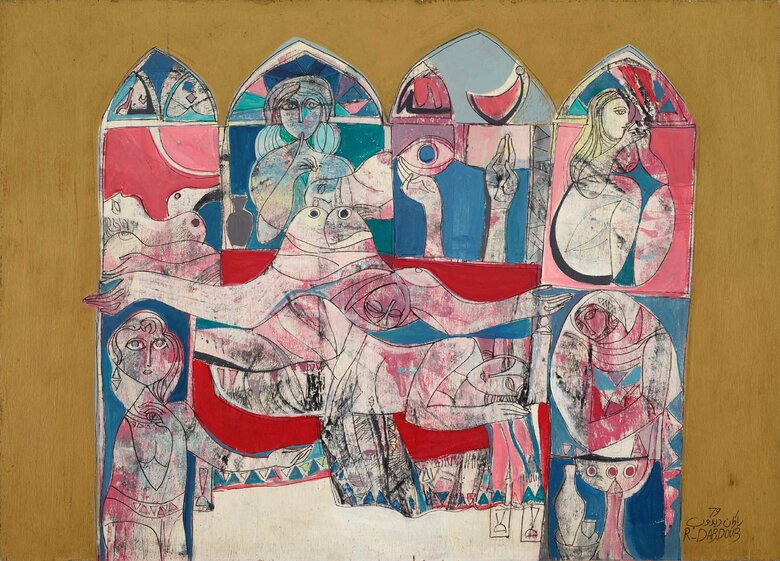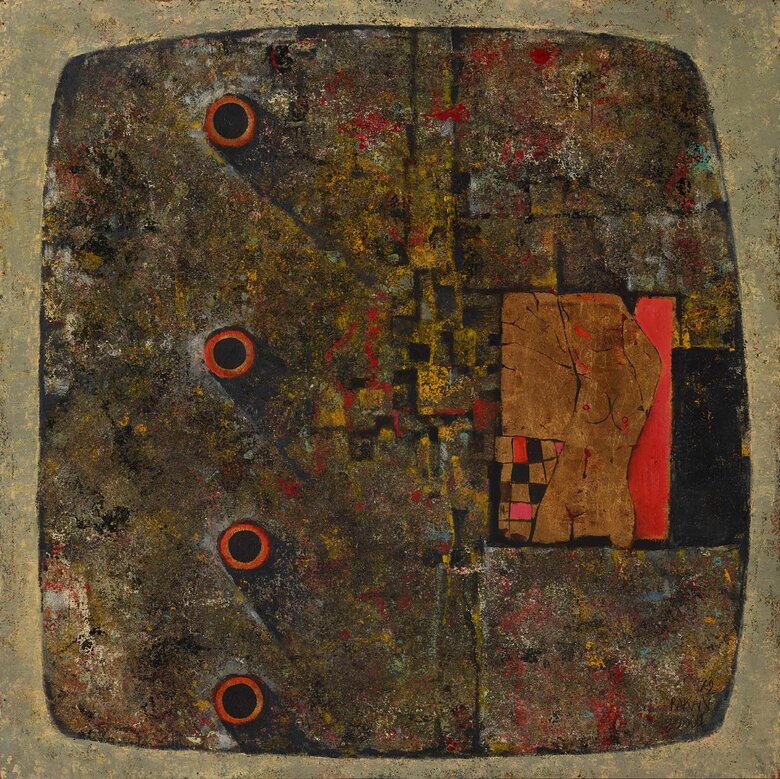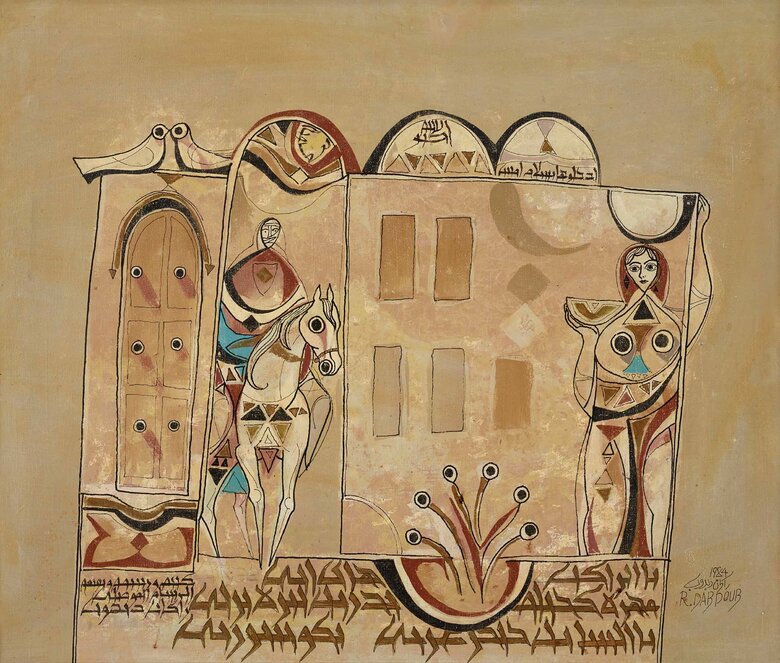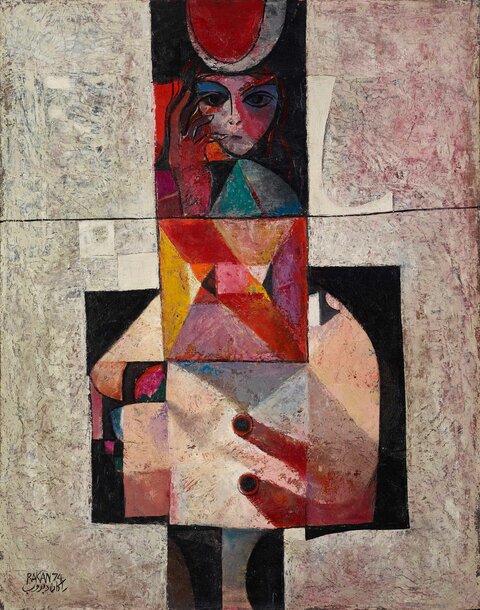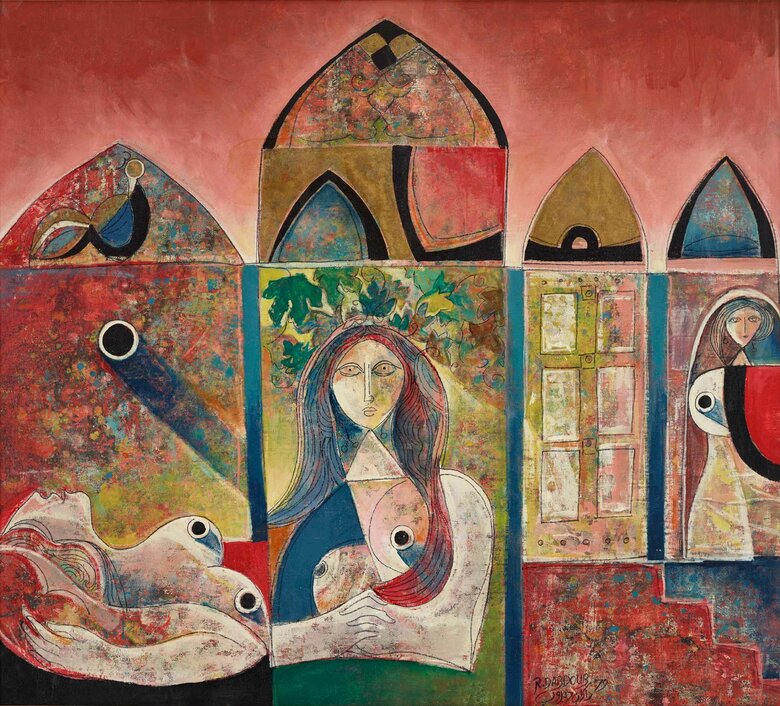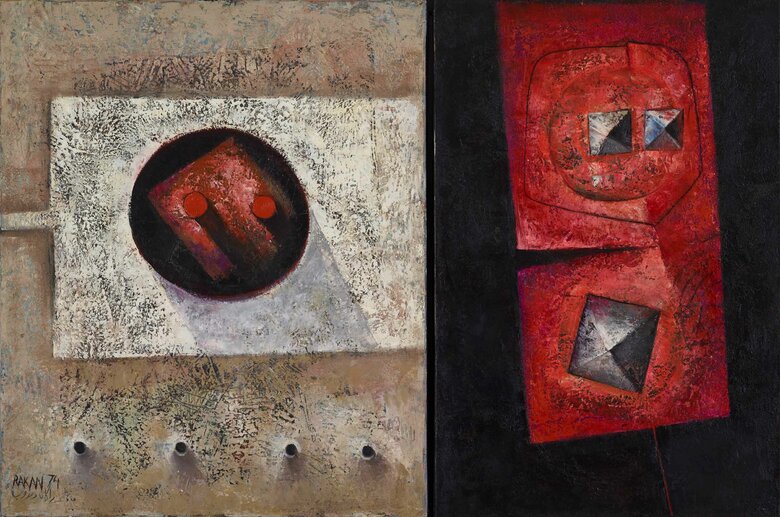Written by Mysa Kafil-Hussain “The artist Rakan Dabdoub, who is known for his abundance and passion for art, and his keen desire to embody art with high human values, has created a special and...
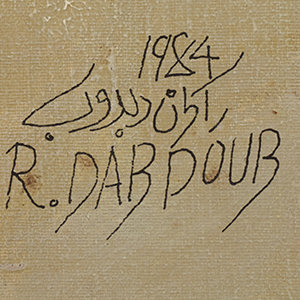

RAKAN DABDOUB, Iraq (1941 - 2017)
Bio
Written by Mysa Kafil-Hussain
“The artist Rakan Dabdoub, who is known for his abundance and passion for art, and his keen desire to embody art with high human values, has created a special and distinguished artistic world, and thus was able to form a space in the Iraqi plastic scene”
Farouk Youssef on Rakan Dabdoub[1]
A loyal and loving son of Mosul, Rakan Dabdoub was born in the city in 1940, and would become one of its most accomplished modern artists. His mother introduced him to poetry and literature, whilst his grandfather guided him through the depths of Mosul’s countryside, mountain villages and nearby Bedouin communities.[2] This exposure to the environment, the people, and also to Iraq’s cultural heritage had a profound impact on Dabdoub’s drawings and sculptures later in his life. He first showed clear signs of his creative spark during his younger years, seeing the artistic potential in the world around him, fondly remembering his mother teaching him to write: “my mother would teach me to write the letter ‘Y’, drawing a duck for me. I liked drawing the duck more than I loved the letter ‘Y’.”[3] His interest in art increased during his school years, with a young Dabdoub struggling to keep on top of his other studies as a result. Nevertheless, he enrolled at the Institute of Fine Arts in Baghdad in the late 1950s, graduating in 1961.
Dabdoub spent his time at the Institute amongst professors who were also masters of their creative fields, such as Faik Hassan, Faraj Abbo, Ismail al-Cheikhli and Atta Sabri, as well as Khaled Al Rahhal in the Institute’s sculpture department, who Dabdoub supported with many of his works.[4] After graduating, he travelled to Italy to complete his higher studies at the Accademia di Belle Arti in Rome. Whilst in Rome during the early 1960s, Dabdoub exhibited his work in a range of group exhibitions during which he subsequently won many awards, also having the space to develop his personal artistic style away from the foundations of his training in Baghdad. He graduated in 1965, but the legacy of his time in Rome stayed with him. He had gained a great deal of knowledge there, including the art of wood carving, elements of which we can see influenced much of his later artworks.[5] To him, Rome was somewhere he could study the classical foundations of sculpture, drawing, art history and anatomy, and also visit some of the most renowned artistic institutions in the world. In Rome, he also crossed paths with artists from all over the world, but also with other Iraqi students in the city, including Ismail Fattah and his wife Liza Fattah, Ghazi al-Saudi and Miran al-Saadi.[6] Dabdoub then returned to Mosul, and joined the University of Mosul’s Engineering Department as an art teacher.
Dabdoub was very active during the 1970s, participating in a range of cultural events and initiatives in Baghdad as well as maintaining his job and an artistic presence in Mosul. His work developed extensively, and his references to Iraqi heritage, folklore and the local environment became key elements of his creative output. The majority of Dabdoub’s artworks in the Dalloul Art Foundation Collection are from this decade, including four untitled artworks from 1974, 1978 and 1979 respectively, as well as Aḥlām Dhahbīyya (‘Golden Dreams’) from 1972, al-Ṣamt al-Mutakalim (‘A Spoken Silence’) from 1973, Aḥlām Imra’at (‘Female Dreams’) from 1974, and Nisā’ al-Ḥayy (‘Women of the Neighbourhood’), also from 1974. This stage of Dabdoub’s work is incredibly varied in terms of subject, but the majority have a textured, grainy appearance akin to reliefs, perhaps a legacy of his work with wood and especially marble, which he was extremely familiar with from the old houses and castles of Mosul. This tactile quality in his work, even on canvas, is understood by Jabra Ibrahim Jabra to be a result of Dabdoub’s training as a sculptor.[7] This intersection of painting, sculpting and carving creates a strong base for the colors and characters, which he paints into many dimensions. Dabdoub manifests figures and structures from a different world, borrowing ideas from ancient mythology, tales of heroes and heroines, and from his own knowledge of ancient Iraqi heritage, with some paintings clearly showing the influence of figural Sumerian statues and their physical features.
The sensual nature of his paintings also veers into the intimate, never shying away from depictions of nudity, especially the female form. Endowing his figures with “touchability”, as suggested by Jabra, Dabdoub uses holes in his paintings, either painted or perforated, to emphasise the presence of everything from a doorknob, to eyes, nipples and flowers, managing to fuse both structural and physical with an erotic allure.[8] This is also evident in his final artwork in the collection, an untitled painting from 1984 that sets a scene reminiscent of many from ancient Arab literature and heritage. Portraying a man on horseback entering an elaborately decorative and traditional world, he approaches a semi-clothed woman in a painting, which would otherwise feel very much at home in the pages of a medieval illustrated manuscript.
The 1980s-1990s were also very busy for Dabdoub. Painting, sculpting and exhibiting regularly, he was then honoured by Iraqi President Saddam Hussein in 1989 with a presidential medal for his work in the arts.[9] In 1993, he retired from his role at the University of Mosul but continued to paint. Towards the end of the 1990s, he started focusing his work more on aspects of Islamic art, calligraphy and the art of hurrifiyya, as well as various creative influences from his studies of the traditional architecture of Mosul.[10] He continued this work for many years, however in 2017, at the age of 76, he passed away in Mosul after a struggle with illness. The city was invaded and occupied by ISIS just two years before which must have had a profound effect on Dabdoub, seeing the destruction of his beloved city which had influenced his work immensely. Beautifully capturing the architectural and artistic heritage of Mosul in his work for over fifty years, Dabdoub’s work ensured that the legacy of the historic city would live on despite the devastation.
[1] Talal Hassan (2017), “طلال حسن : من أعلام العراق؛ الفنان التشكيلي راكان دبدوب”, n.pag
[2] Ibid
[3] Ibid
[4] Ibid
[5] Christie’s (2018) “Rakan Dabdoub – ‘Women of Crafty Mysteries’ – Christie’s: Post War and Contemporary Art, Dubai, 22 March 2018”, n.pag
[6] Hassan (2017), n.pag
[7] Jabra Ibrahim Jabra (1983), The Grass Roots of Iraqi Art, p.60
[8] Jabra (1983), p.62
[9] Wikipedia (n.d.), “راكان دبدوب”, n.pag
[10] Hassan (2017), n.pag
Sources
Jabra, Jabra Ibrahim (1983). The Grass Roots of Iraqi Art. Wasit Graphic and Publishing Limited: Baghdad, Iraq
Talal Hassan (2017). “طلال حسن : من أعلام العراق؛ الفنان التشكيلي راكان دبدوب”, In AlNaked-alIraqi.net. Accessed July 2020. http://www.alnaked-aliraqi.net/article/39471.php
Christie’s (2018). “Rakan Dabdoub – ‘Women of Crafty Mysteries’ – Christie’s: Post War and Contemporary Art, Dubai, 22 March 2018”, In Christies.com. Accessed July 2020. https://www.christies.com/lotfinder/Lot/rakan-dabdoub-iraqi-1941-2017-women-of-crafty-6128080-details.aspx
Wikipedia (n.d.), “راكان دبدوب”, In Ar.Wikipedia.org. Accessed July 2020. http://ar.wikipedia.org/wiki/راكان_دبدوب
CV
Selected Solo Exhibitions
2002
34th Solo Exhibition, Iraqi Creativity Hall, Baghdad, Iraq
2001
Mosul, Iraq
2000
Mosul, Iraq
1985
Baghdad, Iraq
1981
16th Solo Exhibition, Al-Rewaq Gallery, Baghdad, Iraq
Selected Group Exhibitions
2013
Art from Iraq, Al Mashreq Gallery, Kuwait
2012
Park Gallery Booth, Abu Dhabi Art, Abu Dhabi, United Arab Emirates
2005
Nineveh Group Exhibition, French Cultural Center, Baghdad, Iraq
2003
Intact: Iraqi Art, Iraqi Spirit, Aya Gallery, London, United Kingdom
Nineveh Group Exhibition, University of Mosul, Iraq
2002
Nineveh Group Exhibition, Clock Hall, Mosul, Iraq
Baghdad International Festival for Fine Arts, Baghdad, Iraq
1998
Iraqi Art Exhibition, Damascus Art Hall, Damascus, Syria
1995
Hall of the Student Center, University of Mosul, Mosul, Iraq
1993
Babylon International Festival, Baghdad, Iraq
World Plastic Arts Festival, Amman, Jordan
1988
Baghdad International Festival of Art: “Art for Humanity”, Saddam Arts Centre, Baghdad, Iraq
1987
Art Day Exhibition, Saddam Arts Center, Baghdad, Iraq
1986
Opening of the Saddam Arts Center, Baghdad, Iraq
1985
Al-Wasiti Festival, Baghdad, Iraq
1984
Al-Wasiti Festival, Baghdad, Iraq
1983
Contemporary Iraqi Art, Egypt; Sudan; Morocco; Tunisia
1982
Contemporary Iraqi Art, Amman, Jordan; Athens, Greece
1980
Contemporary Iraqi Art, Turkey; Paris, France
Exhibition of The Seventh Group, Baghdad, Iraq
1979
Contemporary Iraqi Art, Damascus, Syria; Libya; San Francisco & Washington D.C., United States of America
1977
Contemporary Iraqi Art, London, United Kingdom; Cairo, Egypt
1976
Cagne-sur-Mer International Festival, Cagne-sur-Mer, France
World Plastic Arts Congress, Baghdad, Iraq
Contemporary Iraqi Art, Paris, France
1975
The Third Triennale – India, Lalit Kala Akademi, New Delhi, India
Iraqi Plastic Artists Society Exhibition, Damascus, Syria
1974
First Arab Biennale, Baghdad, Iraq
Lebanese Arab Exhibition, Baghdad, Iraq
Contemporary Iraqi Art, Beirut, Lebanon; Turkey
Iraqi Artists Society: 16th
Annual Exhibition, Baghdad, Iraq
1973
Arab Conference for Fine Arts Exhibition, Baghdad, Iraq
Contemporary Iraqi Art, Moldova
1972
Al-Wasiti Festival, Baghdad, Iraq
Contemporary Iraqi Art, Armenia
1971
Contemporary Iraqi Art, Moscow, Russia; Kuwait City, Kuwait
1966
New Delhi Triennale, New Delhi, India
Affiliations & Memberships
Date unknown
Member, Iraqi Artists Society, Baghdad, Iraq
Date unknown
Member, Iraqi Artists Syndicate, Baghdad, Iraq
Awards
1989
State Prize for Arts & Literature, Baghdad, Iraq
1963
Honorary Diploma & Silver Medal, Journal of Italian and Foreign Artists, Rome, Italy
1962
Honorary Diploma & Silver Medal, Journal of Italian and Foreign Artists, Rome, Italy
Second Prize, Saint Vito Romano Competition, Rome, Italy
Dante Prize, Italian-Arab Cultural Relations Exhibition, Rome, Italy
Collections
Ibrahimi Collection, Amman, Jordan
Jordan National Gallery of Fine Arts, Amman, Jordan
Al Markhiya Gallery Permanent Collection, Doha, Qatar
Ramzi & Saeda Dalloul Art Foundation, Beirut, Lebanon
Press
ثلاثة فنّانين، ثلاثة أجيال_ أعمال تسائل السرديات السائدة.pdf
NNarchive.pdf
Alquds.pdf
ArtsGulf.pdf
AlRiyadh.pdf
AlDiyarLondon.pdf
AlHasso.pdf
AlNaqed-Aliraqi.pdf
BaytalMosul.pdf
AlmadaPaper.pdf
Elaph.pdf
Elfagr.pdf
ArtKuwait.pdf
AyaGallery.pdf
RAKAN DABDOUB Artwork
Become a Member
Join us in our endless discovery of modern and contemporary Arab art
Become a Member
Get updates from DAF
Follow Artists
Save your favourite Artworks
Share your perspectives on Artworks
Be part of our community
It's Free!
We value your privacy
TermsCookiesPrivacy Policies
Become a Member
Get updates from DAF
Follow Artists
Save your favourite Artworks
Share your perspectives on Artworks
Be part of our community
It's Free!
We value your privacy
TermsCookiesPrivacy Policies
Become a Member
Get updates from DAF
Follow Artists
Save your favourite Artworks
Share your perspectives on Artworks
Be part of our community
It's Free!
We value your privacy
TermsCookiesPrivacy Policies
Welcome to the Dalloul Art Foundation
Thank you for joining our community
If you have entered your email to become a member of the Dalloul Art Foundation, please click the button below to confirm your email and agree to our Terms, Cookie & Privacy policies.
We value your privacy, see how
Become a Member
Get updates from DAF
Follow Artists
Save your favourite Artworks
Share your perspectives on Artworks
Be part of our community
It's Free!
We value your privacy
TermsCookiesPrivacy Policies

